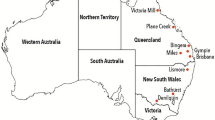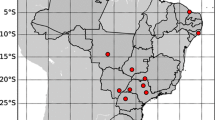Abstract
The summer monsoon rainfall over India is predicted by using neural networks. These computational structures are used as a nonlinear method to correlate preseason predictors to rainfall data, and as an algorithm for reconstruction of the rainfall time-series intrinsic dynamics. A combined approach is developed which captures the information built into both the stochastic approach based on suitable predictors and the deterministic dynamical model of the time series. The hierarchical network so obtained has forecasting capabilities remarkably improved with respect to conventional methods.
Similar content being viewed by others
References
Basu S, Andharia HI (1992) The chaotic time series of Indian monsoon rainfall and its prediction. Proc Indian Acad Sci (Earth Planet Sci) 101:27–34
Cybenko G (1988) Continuous valued neural network with two hidden layers are sufficient. Report, Department of Computer Science, Tufts University, Medford
Cybenko G (1989) Approximations by superpositions of a sigmoidal function. Math Control Signal Systems 2:303–314
Das PK (1987) Short- and long-range monsoon prediction in India. In: Fein JS and Stephens PL (eds) Monsoons. John Wiley, New York, pp 549–578
Elsner JB, Tsonis AA (1992) Nonlinear Prediction, Chaos, and Noise. Bull Am Met Soc 73:49–60
Farmer JD, Sidorowich JJ (1988) Exploiting chaos to predict the future and reduce noise. Theoretical Division and Center for Nonlinear Studies. Los Alamos National Laboratory, LAUR-88-901
Gowariker V, Thapliyal V, Sarker RP, Mandal GS, Sikka DR (1989) Parametric and power regression models: New approach to long range forecasting of monsoon rainfall in India. Mausam 40:115–122
Gowariker V, Thaphyal V, Kulshrestha SM, Mandal GS, Sen Roy N, Sikka DR (1991) A power regression model for long range forecast of southwest monsoon rainfall over India. Mausam 42:125–130
Hastenrath S (1985) Climate and Circulation of the Tropics. Reidel, pp 330-352
Hastenrath S (1987) On the prediction of Indian monsoon rainfall anomalies. J Climate Appl Meteor 26:847–857
Hastenrath S (1988) Prediction of Indian Monsoon Rainfall: Further Exploration. J Climate 1:298–304
Henderson HW, Wells R (1988) Obtaining attractor dimensions from meteorological data. Adv Geophys 30:205–237
Moon F (1987) Chaotic vibrations: An introduction for applied scientists and engineers. Wiley, New York
Mooley DA, Paolino DA (1988) A predictive monsoon signal in the surface level thermal field over India. Mon Wea Rev 116:256–264
Pandit SM, Yu SM (1983) Time series and System Analysis with Applications. Wiley, 272 pp
Rumelhart DE, McClelland JL (1986) Parallel distributed processing. MIT Press, London
Rumelhart DE, Hinton GE, Williams RJ (1986) Learning representations by backpropagating errors. Nature 323:533–536
Satyan V (1988) Is there an attractor for the Indian summer monsoon? Proc Indian Acad Sci (Earth Planet Sci) 97:49–52
Shukla M, Mooley DA (1987) Empirical Prediction of the Summer Monsoon Rainfall over India. Mon Wea Rev 115:695–703
Tong H (1983) Threshold Models in Nonlinear Time Series Analysis. Springer-Verlag, 323 pp
Tsonis AA, Elsner JB (1988) The weather attractor over very short time scales. Nature 333:545–547
Tsonis AA, Elsner JB (1989) Chaos, strange attractors, and weather. Bull Amer Meteor Soc 70:14–23
Weigend AS, Huberman BA, Rumelhart DE (1990) Predicting the Future: A Connectionist Approach. Int J of Neural Sys 1:193–209
World Meteorological Organization (1986) Program on longrange forecasting research. LRF Research Rep. Series No. 6 (WMO/TD-No. 87), pp 824
Wu MC (1985) On the prediction of the Indian summer monsoon. Pap Meteor Res (Taipeh) 8 (1): 34–44
Author information
Authors and Affiliations
Rights and permissions
About this article
Cite this article
Navone, H.D., Ceccatto, H.A. Predicting Indian monsoon rainfall: a neural network approach. Climate Dynamics 10, 305–312 (1994). https://doi.org/10.1007/BF00228029
Received:
Accepted:
Issue Date:
DOI: https://doi.org/10.1007/BF00228029




